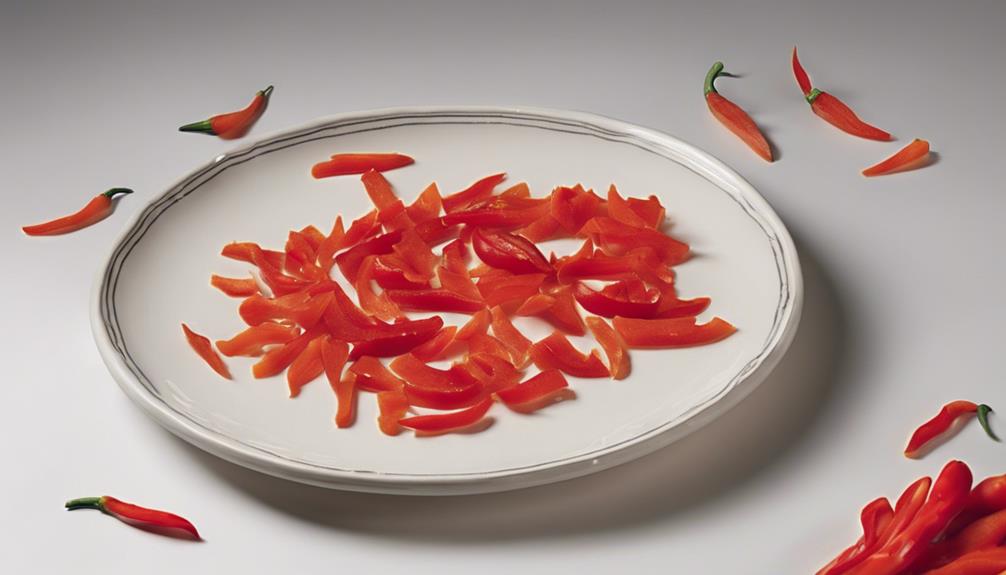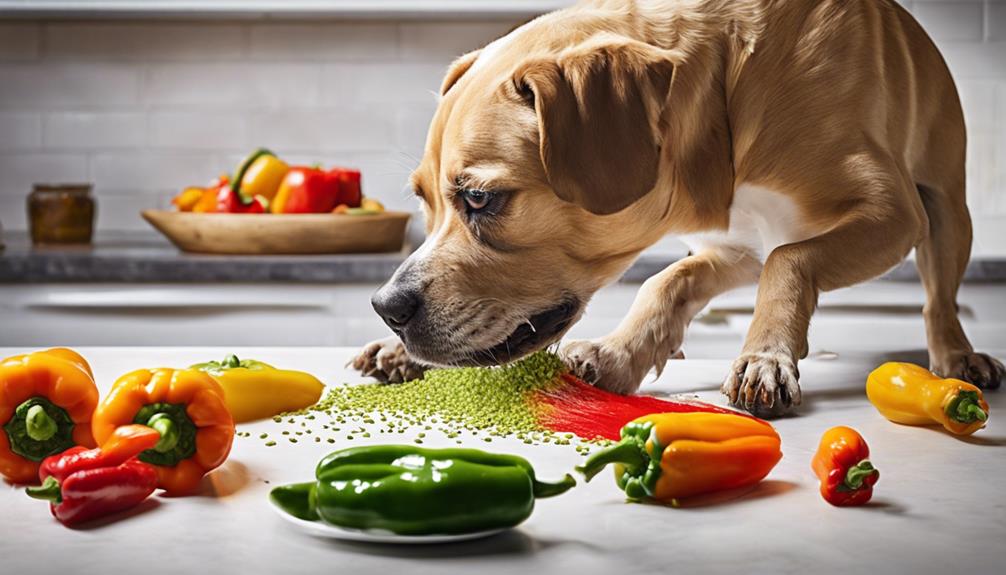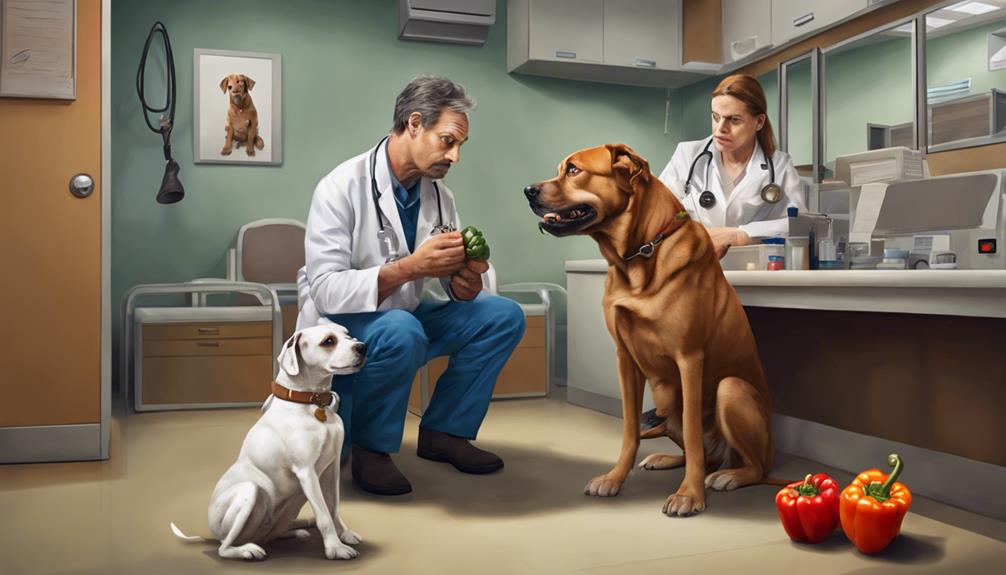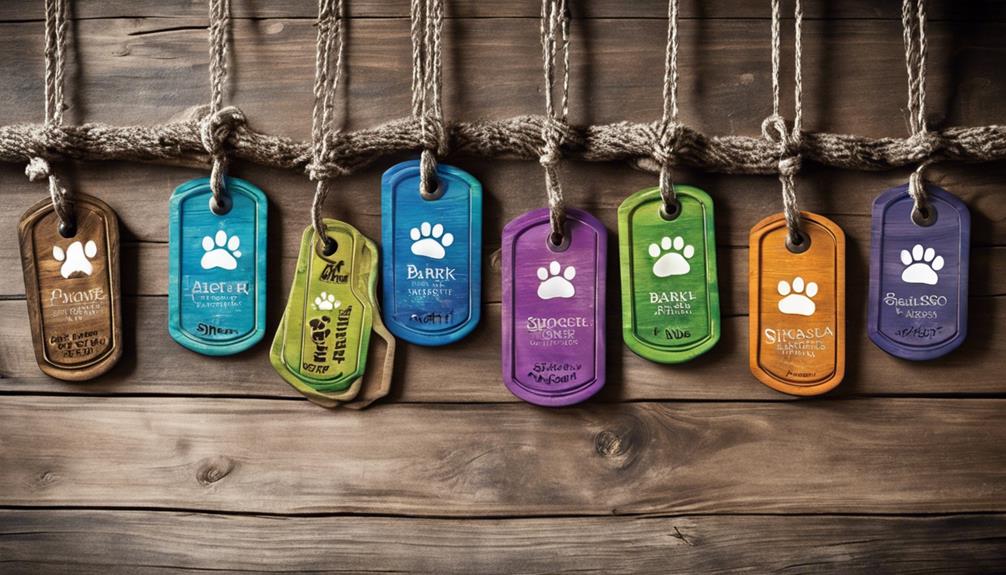Yes, dogs can eat bell peppers safely. Bell peppers are full of essential nutrients like vitamins A, C, E, K, and folate that support a dog's health. They also contain antioxidants that boost overall well-being. Remove the seeds and core before giving raw bell peppers. Cooked bell peppers are a softer option. Offer in moderation a few times a week. Watch out for hot peppers, which can upset a dog's stomach. Consult a vet before introducing bell peppers to your dog for personalized advice. Keep in mind, there's more to learn about feeding bell peppers to your furry friend.
Key Takeaways
- Bell peppers are safe for dogs and offer essential nutrients.
- Remove seeds and core before feeding to avoid choking hazards.
- Consult a vet for personalized advice on feeding bell peppers.
- Feed in moderation to prevent digestive issues or upset.
- Avoid hot peppers with capsaicin that can harm dogs.
Bell Peppers: A Healthy Dog Treat
Exploring bell peppers as a nutritious dog treat reveals a wealth of vitamins and benefits for our furry friends. Raw bell peppers are a fantastic addition to your dog's diet.
These colorful veggies aren't only tasty but also packed with essential nutrients like vitamins A, C, E, K, and folate. When dogs eat bell peppers, they're boosting their immune system, getting a good dose of antioxidants, and promoting healthy digestion.
What's more, bell peppers are low in calories, making them an excellent choice for overweight or obese dogs in need of a nutritious snack.
Variety of Bell Pepper Colors for Dogs

Different colored bell peppers, such as red, green, yellow, and orange, provide similar nutritional benefits for our furry friends. Including a variety of bell pepper colors in your dog's diet not only adds visual appeal but also offers nutrient diversity.
Your pup can enjoy the taste and texture variances while reaping the range of vitamins and antioxidants these colorful veggies provide.
Nutritional Benefits for Dogs
Including a variety of bell pepper colors in our dog's diet can greatly enhance their overall health and well-being by providing a range of essential vitamins and nutrients. Each color of bell pepper offers distinct benefits; for instance, red bell peppers are rich in vitamin C, green ones provide vitamin K, yellow peppers contain vitamin A, and orange peppers supply vitamin E and folate.
Incorporating these different colors guarantees that your dog receives a diverse array of nutrients that promote their immune system, vision, and overall health. The best part is that all these colors are safe for dogs and can be combined to create a colorful and nutritious addition to their meals. So feel free to add some bell peppers to your furry friend's diet for a tasty and healthy boost!
Safe Preparation Methods
Incorporating a range of bell pepper hues in our dog's meals guarantees they obtain a diverse array of indispensable vitamins and nutrients for peak health and well-being. Bell peppers, available in red, green, yellow, and orange, offer various health benefits when included in your dog's diet.
To prepare bell peppers safely for dogs, make sure to remove the seeds and stem before serving to prevent any potential digestive issues. Whether raw, cooked, or grilled, bell peppers are safe for dogs to consume, providing flexibility in how you offer this source of vitamins.
Opting for natural bell peppers without any seasonings ensures a healthy treat option for your furry friend, promoting their overall well-being.
Nutritional Benefits for Dogs

Bell peppers offer a wealth of essential vitamins and nutrients that contribute to the overall health of dogs. They are high in fiber, supporting digestive health and aiding in proper digestion and bowel movements. Additionally, bell peppers are a great option for overweight or obese dogs due to being low in calories. These colorful vegetables are rich in antioxidants, which help boost the immune system and protect cells from damage in dogs. By including a variety of bell pepper colors in a dog's diet, they can benefit from a diverse range of nutrients that promote their well-being.
| Nutrient | Benefits |
|---|---|
| Vitamins A, C, E, | Essential for overall health |
| K, and folate | |
| High fiber | Supports digestive health |
| Antioxidants | Boosts the immune system and protects cells |
Safe Forms of Bell Peppers for Dogs

When considering safe forms of bell peppers for dogs, it's crucial to note that raw bell peppers, cooked bell peppers, and the removal of bell pepper seeds are key aspects to focus on.
Raw bell peppers offer higher vitamin content but require the removal of seeds and core before feeding them to your furry friend.
Some dogs may prefer the taste and texture of cooked bell peppers, ensuring a variety in how you offer this nutritious treat.
Raw Bell Peppers
Raw bell peppers can be a nutritious and crunchy snack option for dogs when prepared correctly. These veggies are packed with essential vitamins like A, C, E, K, and folate, promoting overall health for your furry friend. To guarantee safety, wash the bell peppers thoroughly, remove the seeds and stems, then cut them into small, manageable pieces. Feeding raw bell peppers in moderation is key due to their high fiber content, which can aid in digestion. Check out the table below for a quick reference on the benefits of raw bell peppers:
| Benefit | Description |
|---|---|
| High in Vitamins | Rich in essential vitamins like A, C, E, K, and folate for a healthy dog diet. |
| Crunchy Treat | Provides a satisfying crunch for dogs while offering a nutrient-packed snack option. |
| Digestive Health | The high fiber content can aid in digestion when fed to dogs in moderate amounts. |
Cooked Bell Peppers
After enjoying the benefits of raw bell peppers, exploring the cooked forms becomes a natural progression for dog owners seeking variety in their pet's diet. Cooked bell peppers are a safe option for dogs, providing a softer texture that some pups may find more appealing.
Heating bell peppers through methods like steaming or grilling can enhance their flavor without compromising their nutritional value. Cooking bell peppers also helps in breaking down tough fibers, making them easier for dogs to digest.
When preparing cooked bell peppers for your furry friend, remember to avoid adding any seasonings or ingredients that could be harmful. By incorporating cooked bell peppers into your dog's diet, you can offer them a tasty and nutritious alternative to raw veggies.
Bell Pepper Seeds
Bell pepper seeds are a safe and nutritious addition to a dog's diet, offering additional fiber and essential nutrients. Including these seeds in moderation can be a healthy choice for your furry friend. The nutritional value they provide can complement your dog's overall diet.
When feeding bell pepper seeds to your dog, it's important to make sure that you remove the stem and leaves first. By offering these seeds in small quantities, you can help prevent any potential digestive issues in dogs. Remember, moderation is key when introducing new foods to your dog's diet.
Proper Preparation for Dogs

When preparing bell peppers for dogs, it's essential to wash and cut them into bite-sized pieces, removing seeds and stems to prevent digestive issues.
Here are some tips for properly preparing bell peppers for your canine companion:
- Wash the bell peppers thoroughly to remove any dirt or pesticides that may be present on the skin.
- Cut the bell peppers into small, manageable pieces to make it easier for your dog to eat and digest.
- Remove the seeds and stems from the bell peppers as they can be difficult for dogs to chew and may cause digestive upset.
- Offer the bell peppers either raw or cooked to provide variety in texture and taste for your dog.
- Avoid adding any seasoning or spices to the bell peppers when preparing them for your dog to prevent any potential health risks.
Recommended Bell Pepper Portions for Dogs

How much bell pepper is recommended for dogs of different sizes?
When it comes to feeding bell peppers to our canine companions, the amount varies based on the size of the dog. For small breeds, it's best to start with 1-3 thin slices or a small chunk of bell pepper. Medium-sized dogs can safely consume up to half a bell pepper, cut into manageable pieces. Larger breeds, on the other hand, can be offered a whole bell pepper, starting with half to make sure they react well to it.
While bell peppers are safe for dogs and contain beneficial amounts of vitamins, it's important to remember that they shouldn't replace a dog's regular diet. Instead, they can be given as a treat or mixed into their food a few times a week. It's crucial to introduce bell peppers gradually and monitor your furry friend for any adverse reactions. By following these recommendations, you can safely feed bell peppers to your dogs and provide them with added nutrients in moderation.
Frequency of Bell Pepper Feeding

After determining the recommended portions of bell pepper for dogs based on their size, we can now address how often this nutritious vegetable can be included in their diet. When deciding how frequently to feed dogs bell peppers, remember to keep it as a special addition rather than a primary meal component. Here are some tips to guide you on how often to incorporate bell peppers into your dog's diet:
- Treat your furry friend to bell peppers in small pieces a few times a week.
- Remember that moderation is key when feeding bell peppers to your dog.
- Use bell peppers as a healthy treat to reward good behavior during training sessions.
- Mix bell peppers into your dog's regular food occasionally to add variety.
- Always monitor your dog's response and adjust the frequency based on their enjoyment and digestive well-being.
Risks of Dogs Eating Hot Peppers

Hot peppers pose potential risks to dogs due to the presence of capsaicin, which can cause digestive upset and discomfort.
Consuming spicy peppers like jalapenos, chili peppers, or habaneros can lead to stomach issues such as vomiting, diarrhea, excessive drooling, and abdominal pain in dogs. The capsaicin in hot peppers can irritate a dog's gastrointestinal tract, potentially causing inflammation and discomfort.
It's important to keep hot peppers away from dogs to prevent any adverse reactions or digestive problems. If a dog accidentally consumes hot peppers, it's vital to monitor them closely for any signs of stomach upset or distress. Immediate veterinary attention may be necessary if severe symptoms like persistent vomiting or diarrhea occur.
To safeguard your furry friend's health and well-being, always be cautious and keep spicy peppers out of reach to avoid any potential health risks associated with capsaicin.
Consulting a Vet for Bell Pepper Feeding

When considering feeding bell peppers to your dog, consulting a vet is essential to ensure their health and well-being. Here are some reasons why seeking veterinary advice before introducing bell peppers to your dog's diet is vital:
- Vets can provide personalized advice tailored to your dog's specific health and dietary requirements.
- They can recommend safe portion sizes of bell peppers based on factors like your dog's size, age, and any existing health conditions.
- Vets can identify any potential allergies or sensitivities your dog may have to bell peppers, ensuring a safe feeding experience.
- Seeking veterinary guidance can help prevent digestive issues or adverse reactions that may arise from introducing new foods like bell peppers.
- Vets can offer valuable insights on the preparation and serving of bell peppers to maximize nutritional benefits and minimize any potential risks for your furry friend.
Frequently Asked Questions
Can Dogs Eat Raw Bell Peppers?
Yes, dogs can eat raw bell peppers. They're safe and packed with vitamins A, C, E, and K, which support the immune system.
It's crucial to remove the seeds and stem to prevent digestive issues. Introduce bell peppers gradually to monitor your dog's reaction.
They make a crunchy and healthy treat option. Enjoy watching your furry friend savor this nutritious snack!
What Are the Best Vegetables for Dogs?
When it comes to the top vegetables for dogs, we suggest bell peppers, broccoli, carrots, and cauliflower as nutritious options. Other secure choices include celery, cucumbers, green beans, lettuce, and sweet potatoes. Remember to provide tomatoes and zucchini in moderation.
Avoid toxic vegetables like onions, garlic, and chives. Offering a variety of veggies guarantees your furry friend receives essential vitamins and minerals for a balanced diet.
Can Dogs Eat Cheese?
Yes, dogs can eat cheese, but it should be given in moderation. Cheese can be a tasty treat for dogs due to its high fat and calorie content. However, some dogs may have lactose intolerance, so watch for any digestive issues. Cottage cheese or hard cheeses like cheddar or mozzarella are better options.
Cheese can provide protein and calcium, but too much can lead to obesity. Always consult with a vet before including cheese in your dog's diet.
Can Dogs Eat Bananas?
Yes, dogs can eat bananas safely. They're a good source of potassium, vitamin C, and fiber for our furry friends. Bananas can aid in digestion and provide energy.
However, due to their high sugar content, they should be given as an occasional treat. Remember to always remove the peel and cut bananas into small pieces to prevent choking.
Be mindful of portion sizes to keep our pups healthy and happy.
Conclusion
To sum up, bell peppers can be a healthy and safe treat for dogs when given in moderation.
The variety of colors and nutritional benefits make them a great addition to your dog's diet.
Remember to properly prepare and portion the bell peppers for your furry friend.
If you have any concerns or questions, consult your vet for guidance.
Your pup will thank you for this tasty and nutritious snack option!










